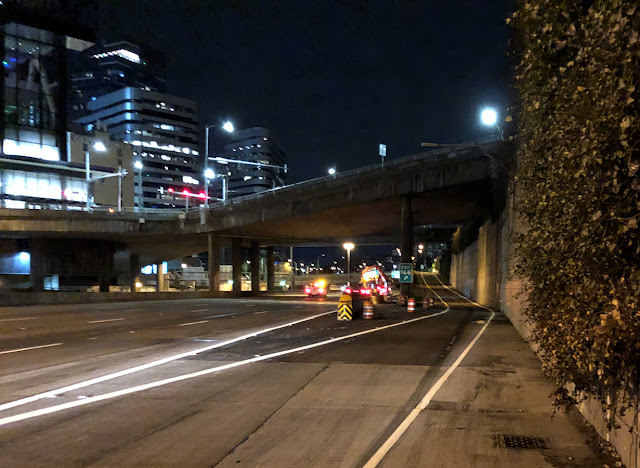By Angela Cochran
There may not be a pot of gold at the end of the rainbow, but the fish in Purdy Creek will think they hit the jackpot once our crews correct these culverts. The good news for the fish and human travelers is that work is finally kicking off on State Route 302/Purdy Drive very soon.
To recap, our project at Purdy Creek kicked off last fall on SR 16. At the time, crews were also scheduled to start work under SR 302/Purdy Drive. However, you know what they say about the best-laid plans – and that proved to be true. A combination of the weather and supply chain issues delayed the SR 302/Purdy Drive portion of the project. Our contractor now has the needed equipment in hand, and we are looking at work starting this spring.
 |
| Crews use heavy equipment and dump trucks to excavate the roadway on westbound SR 16 in preparation for building the new bridge |
What this means for parking on Purdy Lane Northwest near Peninsula High School
First things first, crews must pave Purdy Lane Northwest to create the detour route for SR 302/Purdy Drive. This means a work zone will soon appear on Purdy Lane Northwest, near Peninsula High School. It also means shoulder parking will not be available on Purdy Lane Northwest for about eight months.
We understand that the shoulders on this county road are a popular spot for students to park while at the high school. For several months, however, travelers will need to use Purdy Lane Northwest as part of the detour. No parking will be allowed starting this spring through the end of the 2023 school year. The same parking restrictions will still be in place when school resumes in the fall and through early winter. We also understand that this, at the very least, is an inconvenience for people who park at this location. Please know we would not make these temporary changes unless they were necessary. Crews will work as efficiently and safely as possible to get the work done in order to reopen the parking.
Once crews finish paving the detour and activate the temporary signal at 144th Street and Purdy Lane Northwest, we will close the section of SR 302/Purdy Drive between the high school and 144th Street. The detour route, which will be used by motor vehicles as well as bicycles, will open. Keep in mind, Purdy Lane Northwest is a much narrower road than SR 302/Purdy Drive, even with the shoulder in use, so all users of the road will need to work together to give each other the space needed to safely travel the detour.
Customers heading to businesses located off SR 302/Purdy Drive will still have full access.
 |
| Once we close SR 302/Purdy Drive this spring, the detour will be via Purdy Lane Northwest and 144th Street Northwest. |
Expect upcoming SR 302 around-the-clock closure and detour route
An around-the-clock total closure of the highway will be in place for up to eight months while crews remove the old culvert and replace it with a new bridge. You may wonder why these projects take so long. There is a small period of time during the summer that crews can actually work in the water without causing stress to the fish. Any delays on a project can bump work out an entire year.
Even with our delay for SR 302, we are still within the original anticipated timeframe of two years for the entire project.
So, when is all this happening? Paving and striping is weather-dependent work, so we need it to be dry. We are hopeful this work will begin sometime in March. We will update our project webpage with timelines as they become available. Real-time information is also available on our Travel Center Map.
 |
| Crews need to drill and excavate to lay the foundation for the bridge. |
SR 16 construction reaches milestone
Meanwhile, the westbound portion of SR 16 is approaching its halfway point. Last fall, crews installed a temporary route around the work zone and shifted traffic into the median. Then they started the long work of building the bridge that is replacing the culvert. It kind of looks like they have been digging a big hole – and that is true.
Crews need to do a lot of drilling and excavating before they can start constructing the bridge. This allows them to lay the foundation. They have been doing that throughout the winter. Once crews finish working on the westbound side of SR 16, we will shift traffic onto the new bridge and move the eastbound traffic to a temporary route through the median. Then we will repeat the process on the eastbound side of the bridge. We expect that to happen sometime this fall. When both bridges are complete, travelers will be able to use the two new bridges for both directions of SR 16. That is when work will start underneath the bridges. Crews will excavate under the new spans to create a new and improved route for the creek. The overall effort will remove barriers to fish and open potential habitat.
 |
| Chum salmon spotted swimming in Purdy Creek near the SR 16 work zone |
Slow down, pay attention, be kind
Travelers are likely going to see a lot of orange construction cones everywhere you go this year. As a reminder, please pay attention in work zones. Slow down and drive the posted speed. Stay calm, expect delays, and give yourself extra travel time. We want our workers to go home safely at the end of their shifts. Thank you for helping us make this a reality.















